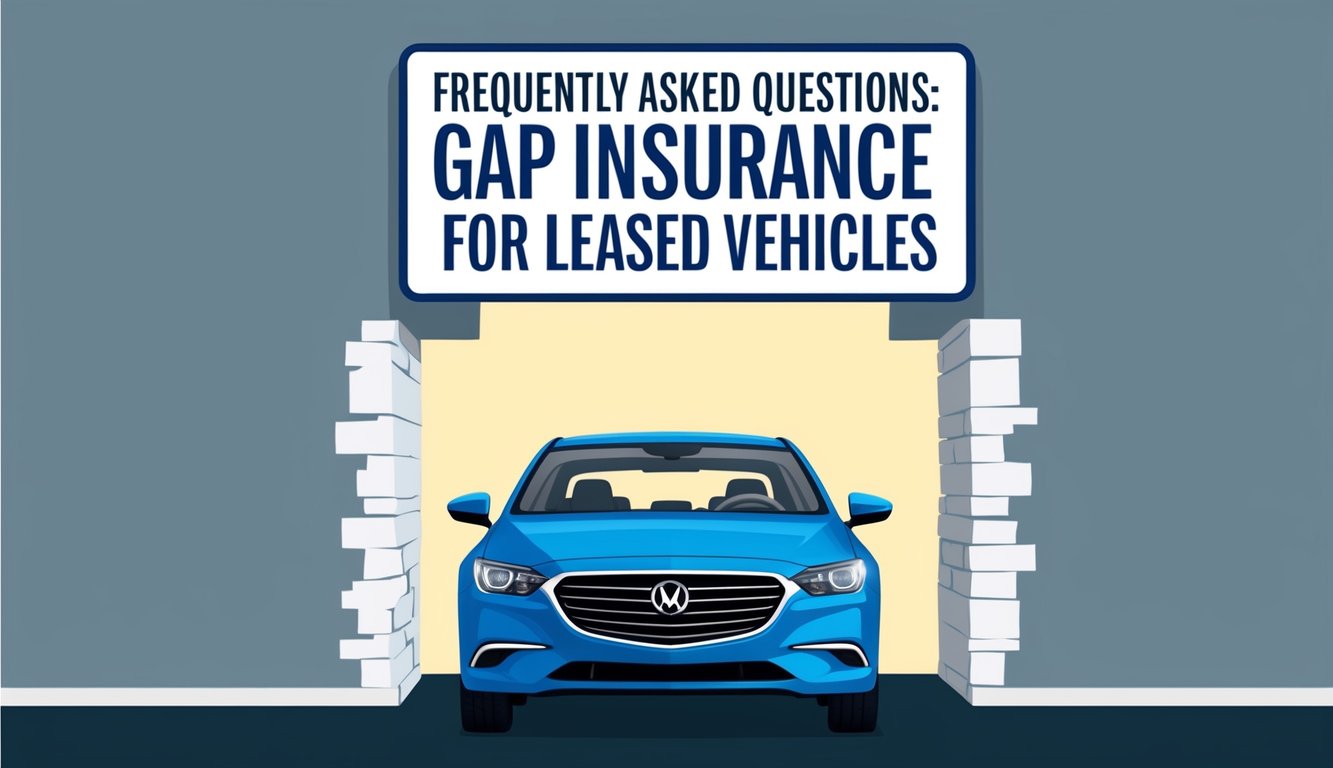When you lease a vehicle, you might wonder if gap insurance is really necessary.
Gap insurance is essential because it protects you from owing money on a car that is no longer worth its value.
Leasing a car often means you’re responsible for the difference between what you owe and the car’s market value if it’s totaled or stolen.
Understanding how gap insurance works can save you from unexpected financial burdens.
Many leasing companies require gap insurance, but even if it’s not mandatory, you should consider it.
As cars depreciate quickly, having this coverage can provide peace of mind.
It ensures that you won’t be left paying for a car that you can no longer drive.
Before deciding, it’s important to know how to acquire gap insurance and what costs are involved.
This simple coverage can make a big difference in your financial security when leasing a vehicle.
Key Takeaways
- Gap insurance protects you from owing more than your car’s worth.
- It is often required by leasing companies.
- Understanding costs and how to get it can ease financial stress.
What Is Gap Insurance?
Gap insurance is an important type of coverage for those leasing a vehicle.
It fills the financial gap between what you owe on your lease and the actual cash value of the vehicle if it’s totaled or stolen.
Understanding its definition and how it compares to standard auto insurance is crucial for making informed decisions.
Definition and Coverage Scope
Gap insurance specifically covers the difference between the amount you still owe on your lease and the vehicle’s current market value after a total loss.
For instance, if your leased car is worth $20,000 at the time of an accident, but you still owe $25,000, gap insurance pays the $5,000 difference.
This type of insurance is beneficial when you have a high depreciation vehicle or made a small down payment.
Standard auto insurance only pays what the car is worth, which may leave you with a financial loss.
Gap insurance protects you from this experience, providing peace of mind during your leasing period.
Gap Insurance Compared to Standard Auto Insurance
Standard auto insurance covers damage to your vehicle, including theft, but does not handle the difference between what you owe and what your car is worth.
If your car is totaled, your insurer will pay you the market value of the car, which can be less than you owe.
In contrast, gap insurance steps in when standard insurance is not sufficient.
It helps prevent you from having to pay out of pocket to cover the remaining balance on your lease.
By combining both types of coverage, you can ensure you’re financially protected in case of an unexpected loss with your leased vehicle.
Importance of Gap Insurance for Leased Vehicles
Gap insurance plays a crucial role in protecting you when leasing a vehicle.
It ensures that you’re financially covered in case your car is totaled or stolen.
This protection is especially important given the unique nature of lease agreements and vehicle depreciation.
Financial Protection for Lease Agreements
When you lease a vehicle, you agree to pay for its use rather than owning it outright.
If your leased vehicle is damaged beyond repair, your primary insurance will only cover its market value at that time.
This means you could be left owing money to the leasing company.
For example, if your leased car is worth $20,000 when it is totaled, but you still owe $24,000, the gap insurance would cover the $4,000 difference.
This safeguard relieves you from potential financial strain and ensures that you’re not left facing unexpected costs.
Depreciation and Loan-to-Value Ratio
Vehicles typically lose value quickly, which is a significant factor in leasing.
The gap between what your insurance pays and what you owe can grow over time.
The loan-to-value ratio can change, especially in the early years of your lease.
For instance, if a car depreciates by 30% in the first year, and you have only made a few payments, your insurance payout may be less than what you owe.
This scenario illustrates the importance of having gap insurance to protect against such losses.
It provides peace of mind, knowing you are financially secure even if the unexpected happens.
How Does Gap Insurance Work?
Gap insurance provides essential coverage for leased vehicles in case of an accident or theft.
It helps ensure that you are not left paying out of pocket for a vehicle that is no longer in your possession.
Claim Process Explained
When your leased vehicle is totaled or stolen, the claim process for gap insurance involves several steps.
First, you need to file a claim with your primary auto insurance for the actual cash value (ACV) of the vehicle.
Once your main insurer processes the claim, they will determine how much they will pay.
This amount is typically less than what you owe on the lease.
After receiving this payout, you can file a claim with your gap insurance provider.
Submit necessary documentation, such as the loss statement from your primary insurer.
Your gap insurance will then cover the difference, ensuring you do not have to pay out of pocket for the remaining balance on your lease contract.
Calculating the ‘Gap’
To understand the ‘gap’ that gap insurance covers, you need to consider two main figures: the ACV of your vehicle and your remaining lease balance.
Step 1: Determine the ACV of your vehicle, which is the amount your insurance company will pay if it is deemed a total loss.
Step 2: Look at the remaining balance on your lease.
This is how much you still owe.
Your ‘gap’ is simply:
Remaining Lease Balance – Actual Cash Value = Gap Amount
If your vehicle’s value is less than what you owe, gap insurance will pay that remaining balance.
This ensures you are not financially burdened after losing your vehicle.
Acquiring Gap Insurance for Your Lease
When you lease a vehicle, acquiring gap insurance can protect you from financial loss if your car is stolen or totaled.
It’s essential to understand your options for purchase and evaluate different providers to make an informed choice.
Options for Purchase
You have several avenues for purchasing gap insurance.
These include options through your leasing company, car insurance providers, and independent insurance agents.
-
Leasing Company: Many leasing companies offer gap insurance as part of the lease agreement. This option may be convenient, but it could be more expensive than alternatives.
-
Car Insurance Provider: Check if your current auto insurance includes gap coverage. This can be a flexible option, bundling your insurance policies.
-
Independent Agents: Independent insurance agents can shop around for the best rates and policies, allowing you to compare coverage options and prices.
Consider your specific needs and the costs of each option before deciding.
Evaluating Different Gap Insurance Providers
When evaluating gap insurance providers, focus on a few critical factors to ensure you make the best selection.
-
Coverage Limits: Understand the maximum amount your provider will cover. Some plans may have caps that vary by company.
-
Premium Costs: Compare rates from different providers. While cheaper isn’t always better, ensure you receive adequate coverage for what you pay.
-
Claims Process: Research how easy or complicated it is to file a claim. A smooth process can save money and time if you need to use the insurance.
-
Customer Reviews: Look up customer feedback and ratings. Providers with good support and service may give you peace of mind.
Take your time to review these factors before choosing a gap insurance provider for your leased vehicle.
Cost of Gap Insurance

Understanding the cost of gap insurance is essential for anyone leasing a vehicle.
The price can vary based on several factors, including where you purchase it and how much coverage you need.
You can also explore ways to lower your insurance costs.
Determining the Premium
The premium for gap insurance can range widely.
Typically, it costs between $500 and $700 when purchased through a dealer.
In some cases, you may pay an additional $600 for dealer-added gap insurance.
If you choose to add it to your auto insurance policy, it may cost approximately $90 per year or about $7.50 per month.
Factors that influence the premium include the type of vehicle, its value, and your driving history.
Lenders or insurance companies may offer different rates, so it’s beneficial to compare quotes.
Ensuring you know the actual cash value (ACV) of your vehicle can also help you gauge how much gap insurance you need.
Ways to Reduce Gap Insurance Costs
You can take several steps to minimize the cost of gap insurance.
First, shop around for the best rates from various providers.
Many traditional auto insurance companies offer gap insurance as an add-on, often at a lower rate than dealerships.
Another effective strategy is to consider your lease agreement details.
If you negotiate a lower price or choose a less expensive vehicle, your gap insurance may cost less.
You might also want to ask about discounts for bundling insurance policies.
Some insurers provide reductions if you combine gap insurance with other forms of coverage like home or auto.
This approach can lead to overall savings without sacrificing necessary protection.
Frequently Asked Questions

When dealing with gap insurance for leased vehicles, you may have several specific questions.
Below are common inquiries that can help clarify how gap insurance works and what you need to know.
Is gap insurance automatically included in auto lease agreements?
No, gap insurance is not typically included in auto lease agreements.
You often need to purchase it separately.
Some leasing companies may require it, but it’s important to check your contract.
How much does gap insurance typically cost for a leased vehicle?
The cost of gap insurance can vary.
On average, it may range from $20 to $40 a year when purchased through your auto insurance provider.
If obtained through a dealership, the cost might be higher.
What is the maximum amount that gap insurance will cover?
Gap insurance generally covers the difference between the amount you owe on your lease and the actual cash value of the vehicle at the time of loss.
This amount can vary based on your lease terms and the vehicle’s value.
What exactly does gap insurance cover for leased vehicles?
Gap insurance covers the amount you owe on your lease if the vehicle is totaled or stolen.
It pays the difference between your lease balance and the vehicle’s current market value, protecting you from financial loss.
Do I require gap insurance if I already possess comprehensive insurance coverage?
Yes, you may still need gap insurance even if you have comprehensive coverage.
Comprehensive insurance covers damage to your vehicle, but it does not cover the gap between what you owe and the vehicle’s value.
How does gap insurance respond when a leased vehicle is declared a total loss?
If your leased vehicle is a total loss, gap insurance will pay off the remaining balance owed on your lease.
This payment ensures you’re not left with debt for a vehicle that no longer exists.






